Experimental Study on the Microstructure and Tribological Properties of Laser-Clad Ni60-WC Composite Coatings
Abstract
:1. Introduction
2. Experimental Materials and Methods
2.1. Experimental Materials
2.2. Experimental Methods
3. Results and Discussion
3.1. Microstructural Analysis of Laser-Clad Composite Coating
3.1.1. SEM Analysis
3.1.2. EDS Elemental Analysis
3.1.3. XRD Spectrum Analysis
3.2. Microhardness Distribution across the Composite Coating Cross-Section
3.3. Study on the Electrochemical Corrosion Performance of the Composite Coating
3.4. Tribological Performance Study of the Laser-Clad Composite Coating
3.4.1. Effect of Normal Load on Friction Performance
3.4.2. Wear Morphology Analysis
3.4.3. The Wear Mechanism of the Composite Coating
4. Conclusions
- The composite coating primarily consists of γ-(Fe, Ni), WC, W2C, M23C6, and M6C phases, with the (Fe, Ni) solid solution supporting these hard phases. A transition area forms in the bonding region between the composite coating and the substrate, where cellular and equiaxed crystals at the top of the composite coating contribute to fine-grain strengthening.
- In the transition area at the interface between the composite coating and the substrate, diffusion behaviors of Fe, Cr, and Ni elements occur, effectively improving the bonding performance of the coating. W and C elements from the decomposition of WC actively participate in the precipitation process of hard carbides, enhancing the hardness of the composite coating. The average hardness of the composite coating reaches 569.5 HV, representing a 103% increase compared to the substrate. The corrosion potential of the composite coating increased by 32.6% compared to the substrate. The corrosion current density decreased by 62.0%. These results indicate that the fabricated composite coating exhibited a reduced corrosion rate and a significant improvement in corrosion resistance.
- As the normal load increases, both the friction coefficient and wear volume of the substrate and composite coating increase. However, under the same normal load, the friction coefficient of the composite coating is reduced by 17.4%, the wear volume is reduced by 79%, and the wear depth is reduced by 54.4%, significantly reducing abrasive wear and fatigue wear. This improvement greatly enhances the tribological performance of the composite coating.
- Research on the Ni60-WC composite coating still lacks sufficient investigation into whether new phases are generated after wear, whether stress distribution changes, and whether there is element migration or consumption. Future studies could focus on the relationship between the microstructure and performance of the coating, as well as further enhancing the understanding of its corrosion resistance. This would contribute to improving the overall performance of the composite coating, expanding its range of applications, and providing more reliable and durable material solutions for marine engineering.
Author Contributions
Funding
Institutional Review Board Statement
Informed Consent Statement
Data Availability Statement
Conflicts of Interest
References
- Chen, L.; He, Y.; Yang, Y.X.; Niu, S.W.; Ren, H.T. The research status and development trend of additive manufacturing technology. Int. J. Adv. Manuf. Technol. 2017, 89, 3651–3660. [Google Scholar] [CrossRef]
- Jin, Y.; Ji, S.; Li, X.; Yu, J. A scientometric review of hotspots and emerging trends in additive manufacturing. J. Manuf. Technol. Manag. 2017, 28, 18–38. [Google Scholar] [CrossRef]
- Wu, S.; Liu, Z.; Huang, X.; Wu, Y.; Gong, Y. Process parameter optimization and EBSD analysis of Ni60A-25% WC laser cladding. Int. J. Refract. Met. Hard Mater. 2021, 101, 105675. [Google Scholar] [CrossRef]
- Cui, G.; Han, B.; Zhao, J.; Li, M. Comparative study on tribological properties of the sulfurizing layers on Fe, Ni and Co based laser cladding coatings. Tribol. Int. 2019, 134, 36–49. [Google Scholar] [CrossRef]
- Li, Q.; Song, G.M.; Zhang, Y.Z.; Lei, T.C.; Chen, W.Z. Microstructure and dry sliding wear behavior of laser clad Ni-based alloy coating with the addition of SiC. Wear 2003, 254, 222–229. [Google Scholar] [CrossRef]
- Sun, R.L.; Mao, J.F.; Yang, D.Z. Microscopic morphology and distribution of TiC phase in laser clad NiCrBSiC–TiC layer on titanium alloy substrate, Surf. Coat. Technol. 2002, 155, 203–207. [Google Scholar] [CrossRef]
- Xu, P.; Lin, C.; Zhou, C.; Yi, X. Wear and corrosion resistance of laser cladding AISI 304 stainless steel/Al2O3 composite coatings. Surf. Coat. Technol. 2014, 238, 9–14. [Google Scholar] [CrossRef]
- Zhu, Y.; Liu, X.-B.; Liu, Y.-F.; Wang, G.; Wang, Y.; Meng, Y.; Liang, J. Development and Characterization of Co-Cu/Ti3SiC2 Self-Lubricating Wear Resistant Composite Coatings on Ti6Al4V Alloy by Laser Cladding. Surf. Coat. Technol. 2021, 424, 127664. [Google Scholar] [CrossRef]
- Li, X.; Zhang, C.H.; Zhang, S.; Wu, C.L.; Liu, Y.; Zhang, J.B.; Shahzad, M. Manufacturing of Ti3SiC2 lubricated Co-based alloy coatings using laser cladding technology. Opt. Laser Technol. 2019, 114, 209–215. [Google Scholar] [CrossRef]
- Ma, Q.; Li, Y.; Wang, J.; Liu, K. Investigation on cored-eutectic structure in Ni60/WC composite coatings fabricated by wide-band laser cladding. J. Alloys Compd. 2015, 645, 151–157. [Google Scholar] [CrossRef]
- Li, C.; Zhang, Q.; Wang, F.; Deng, P.; Lu, Q.; Zhang, Y.; Li, S.; Ma, L.; Wang, Y. Microstructure and wear behaviors of WC-Ni coatings fabricated by laser cladding under high frequency micro-vibration. Appl. Surf. Sci. 2019, 485, 513–519. [Google Scholar] [CrossRef]
- Weng, Z.; Wang, A.; Wu, X.; Wang, Y.; Yang, Z. Wear resistance of diode laser-clad Ni/WC composite coatings at different temperatures. Surf. Coat. Technol. 2016, 304, 283–292. [Google Scholar] [CrossRef]
- Li, M.; Zhang, Q.; Han, B.; Song, L.; Li, J. Microstructure and property of Ni/WC/La2O3 coatings by ultrasonic vibration-assisted laser cladding treatment. Opt. Lasers Eng. 2020, 125, 105848. [Google Scholar] [CrossRef]
- Li, S.; Huang, K.; Zhang, Z.; Zheng, C.; Li, M.; Wang, L.; Wu, K.; Tan, H.; Yi, X. Wear mechanisms and micro-evaluation of WC plus TiC particle-reinforced Ni-based composite coatings fabricated by laser cladding. Mater. Charact. 2023, 197, 112699. [Google Scholar] [CrossRef]
- Li, C.; Liu, C.; Li, S.; Zhang, Z.; Guo, Y. Numerical Simulation of Thermal Evolution and Solidification Behavior of Laser Cladding AlSiTiNi Composite Coatings. Coatings 2019, 9, 391. [Google Scholar] [CrossRef]
- Singh, A.K.; Mundada, Y.; Bajaj, P.; Wilms, M.B.; Patil, J.P.; Mishra, S.K.; Jägle, E.A.; Arora, A. Investigation of temperature distribution and solidification morphology in multilayered directed energy deposition of Al-0.5Sc-0.5Si alloy. Int. J. Heat Mass Transf. 2022, 186, 122492. [Google Scholar] [CrossRef]
- Zhang, H.; Pan, Y.; He, Y.Z. Grain refinement and boundary misorientation transition by annealing in the laser rapid solidified 6FeNiCoCrAlTiSi multicomponent ferrous alloy coating. Surf. Coat. Technol. 2011, 205, 4068–4072. [Google Scholar] [CrossRef]
- Karimi, P.; Sadeghi, E.; Algardh, J.; Keshavarzkermani, A.; Esmaeilizadeh, R.; Toyserkani, E.; Andersson, J. Columnar-to-equiaxed grain transition in powder bed fusion via mimicking casting solidification and promoting in situ recrystallization. Addit. Manuf. 2021, 46, 102086. [Google Scholar] [CrossRef]
- Yu, P.C.; Liu, X.; Lu, X.; Wang, Y.G.; Chen, Y.; Shi, G.L.; Wu, S.H. High-Temperature Tribological Properties of Laser Clad Composite Coatings on Ti6Al4V Alloy. Tribology 2015, 35, 737–745. [Google Scholar]
- Amar, A.; Zhang, L.; Huang, R.; Li, T.; Wang, M.; Lu, Y. Effects of annealing treatment on microstructure and mechanical properties of laser melting-deposited VCoNi medium-entropy alloy. Intermetallics 2024, 165, 108157. [Google Scholar] [CrossRef]
- Lekka, M.; Lanzutti, A.; Leitenburg, D.C.; Fedrizzi, L. Production and microstructural characterization of Ni matrix composite electrodeposits containing either micro- or nano-particles of Al. Surf. Coat. Technol. 2017, 309, 242–248. [Google Scholar]
- Tan, N.; Hu, Z.; Zhou, Y.; Li, Y.; Lu, B.; Hu, D.; Liu, Y.; Li, Q. Effect of WC particle size on the microstructure and tribological properties of high-speed laser cladding Ni/WC composite coatings. Materualstoday 2024, 39, 109066. [Google Scholar]
- Feng, L.; Xiaosong, J.; Zhenyi, S.; Degui, Z.; Zhiping, L. Research Progress Regarding Interfacial Characteristics and the Strengthening Mechanisms of Titanium Alloy/Hydroxyapatite Composites. Materials 2018, 11, 1391. [Google Scholar] [CrossRef] [PubMed]
- Yang, G.R.; Huang, C.P.; Song, W.M.; Li, J.; Lu, J.J.; Ma, Y.; Hao, Y. Microstructure characteristics of Ni/WC composite cladding coatings. Int. J. Miner. Metall. Mater. 2016, 23, 184–192. [Google Scholar] [CrossRef]
- Zhu, S.; Yu, C.; Chang, Z.; Zhan, X.; Zeng, C. Microstructure evolution mechanism of single and multi-pass in laser cladding based on heat accumulation effect for invar alloy. Int. J. Adv. Manuf. Technol. 2021, 117, 3447–3463. [Google Scholar] [CrossRef]
- Elangovan, N.; Srinivasan, A.; Pugalmani, S.; Kalaiyarasan, M.; Rajendran, N.; Asiful, H.; Rajendiran, N. Development and electrochemical investigations of enhanced corrosion-resistant Polyvinylcarbazole-TiO2 hybrid nanocomposite coatings on 316L SS for marine applications. Surf. Coat. Technol. 2024, 481, 130628. [Google Scholar]
- Reza, G.; Polycarpou, A.A. Three-body Abrasive Wear of Hard Coatings: Effects of Hardness and Roughness. Thin Solid Films 2018, 666, 66–75. [Google Scholar]
- García-León, R.A.; Martínez-Trinidad, J.; Zepeda-Bautista, R.I.; Campos-Silva, M.; Guevara-Morales, A.; Martínez-Londoño, J.; Barbosa-Saldaña, J. Dry sliding wear test on borided AISI-316L stainless steel under ball-on-flat configuration: A statistical analysis. Tribol. Int. 2021, 157, 106885. [Google Scholar] [CrossRef]

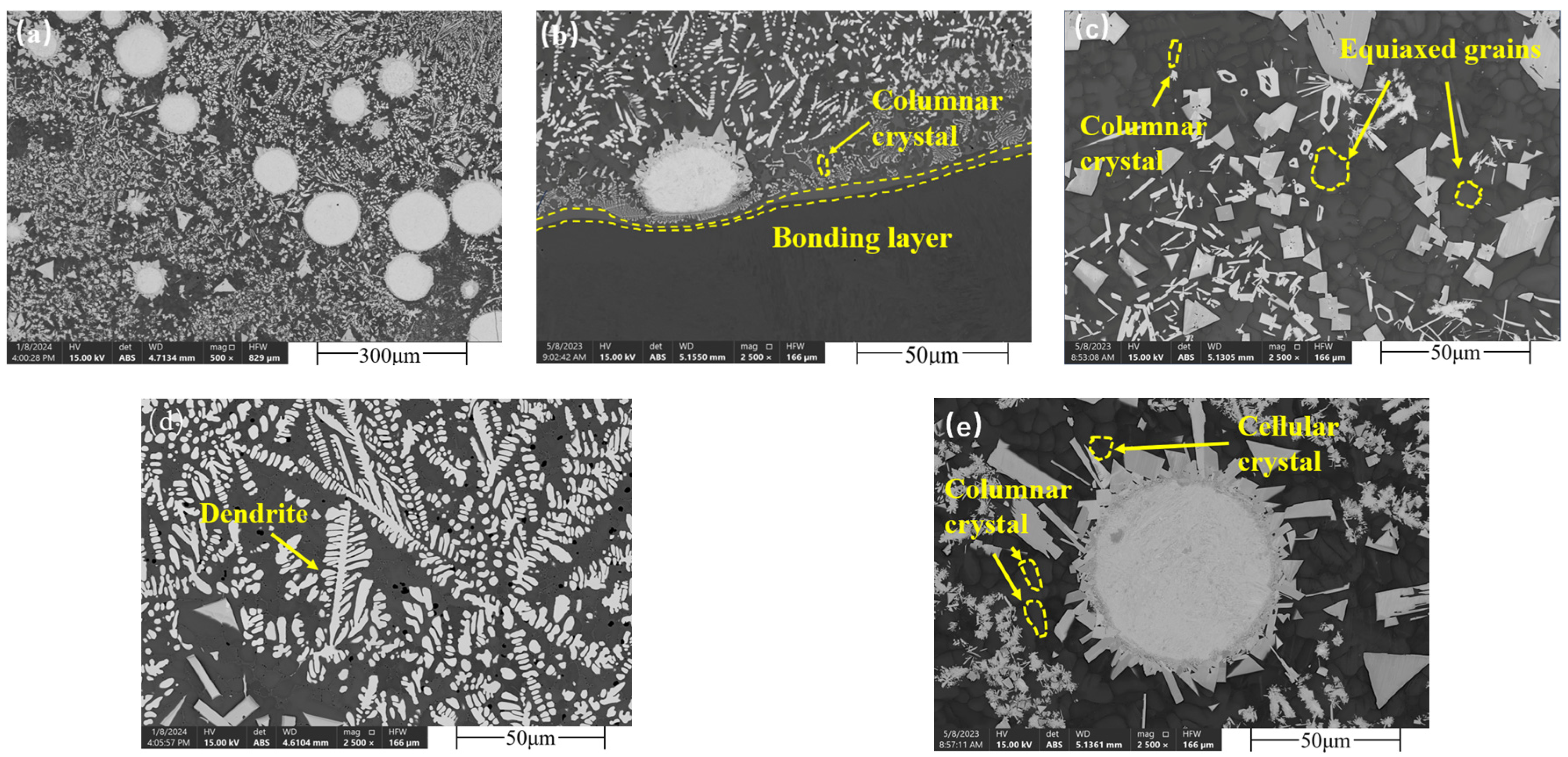



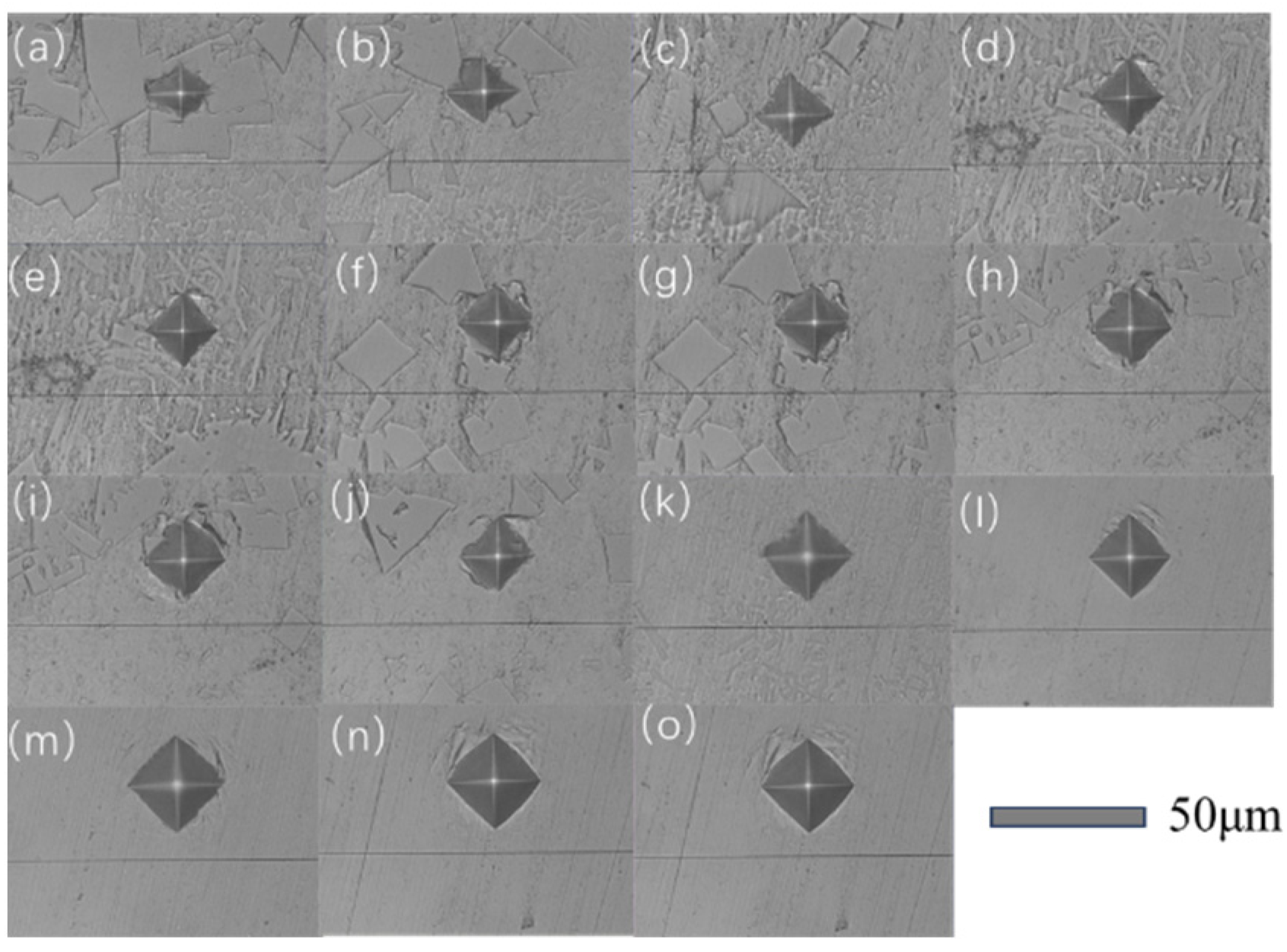
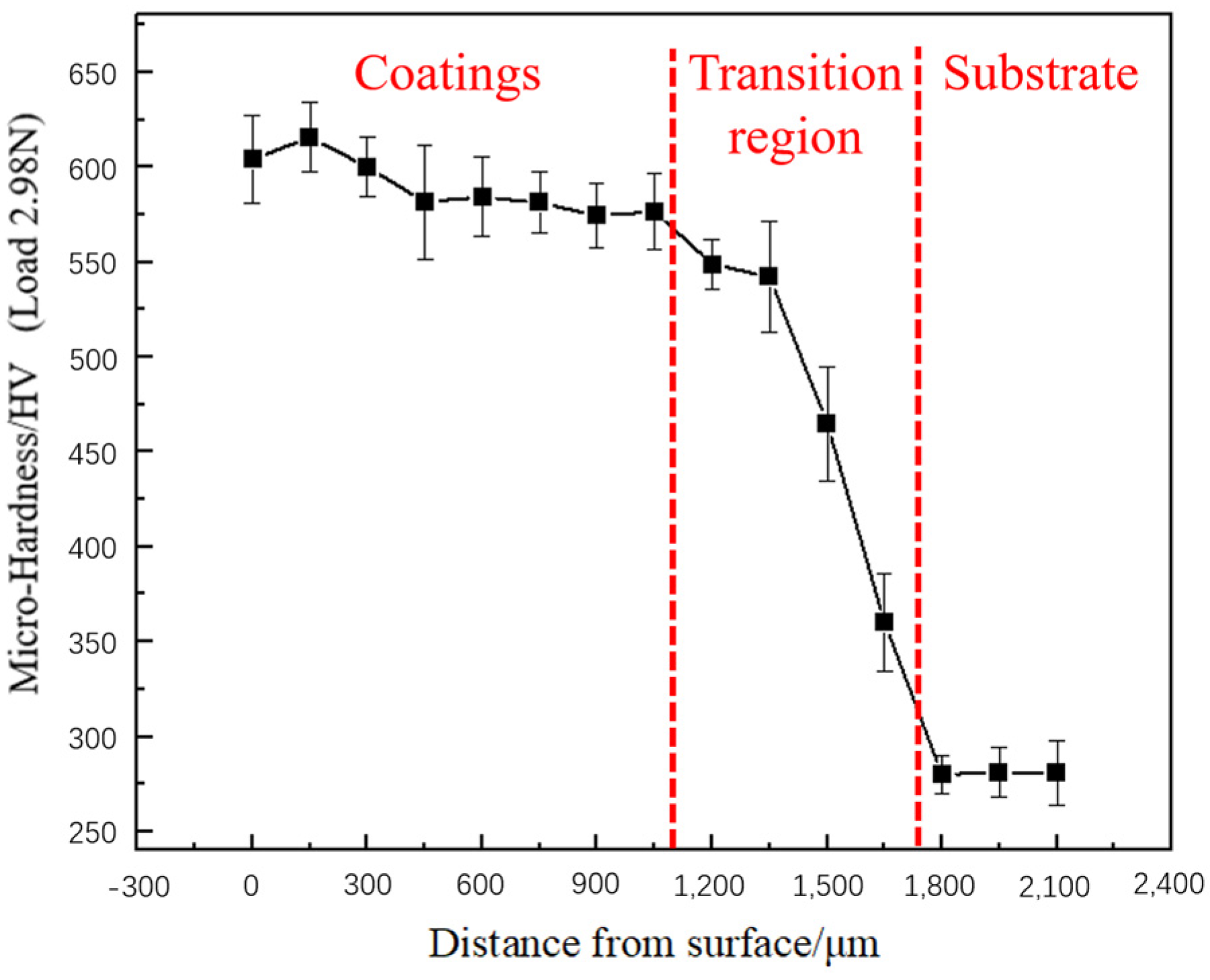

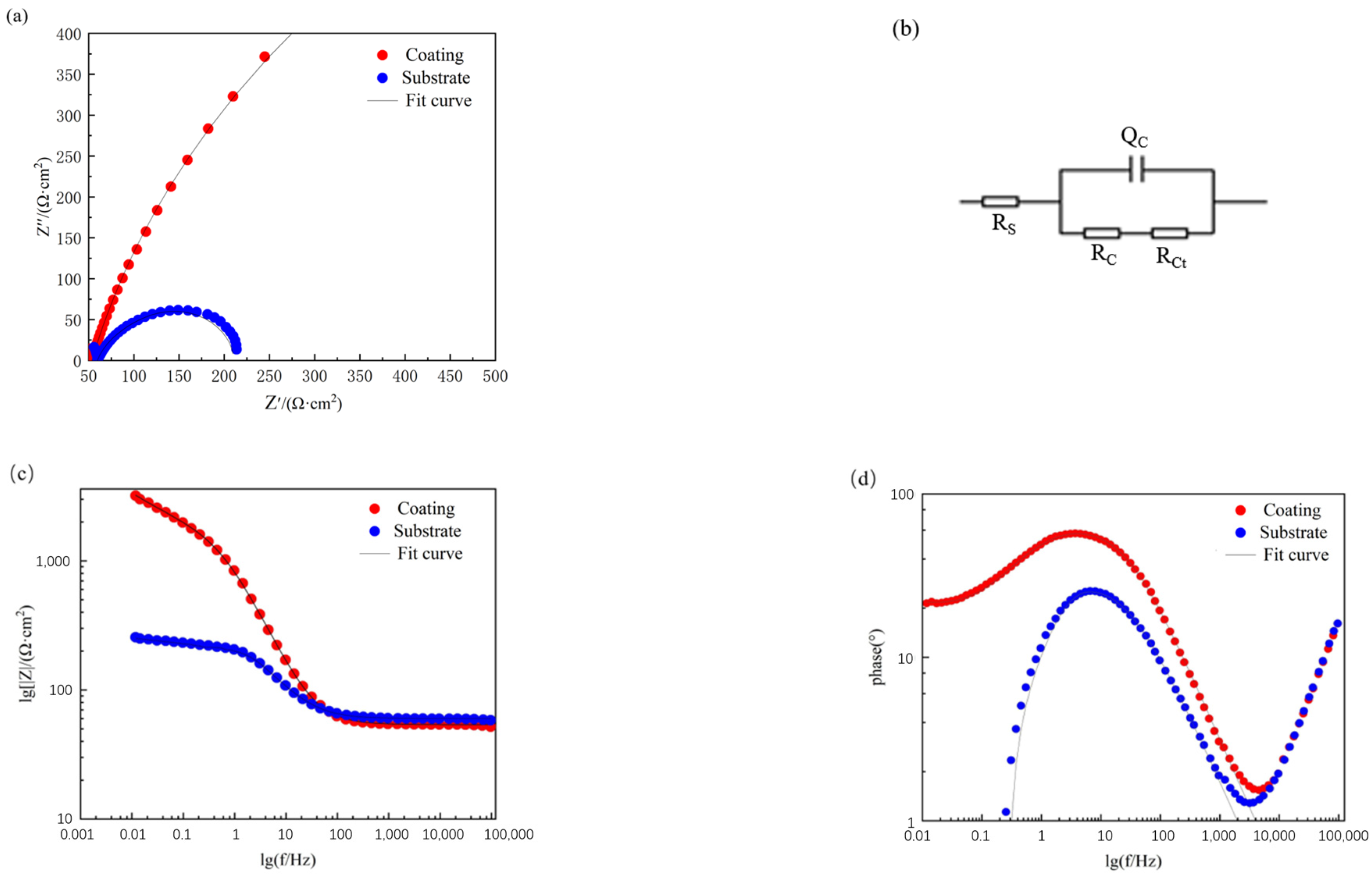
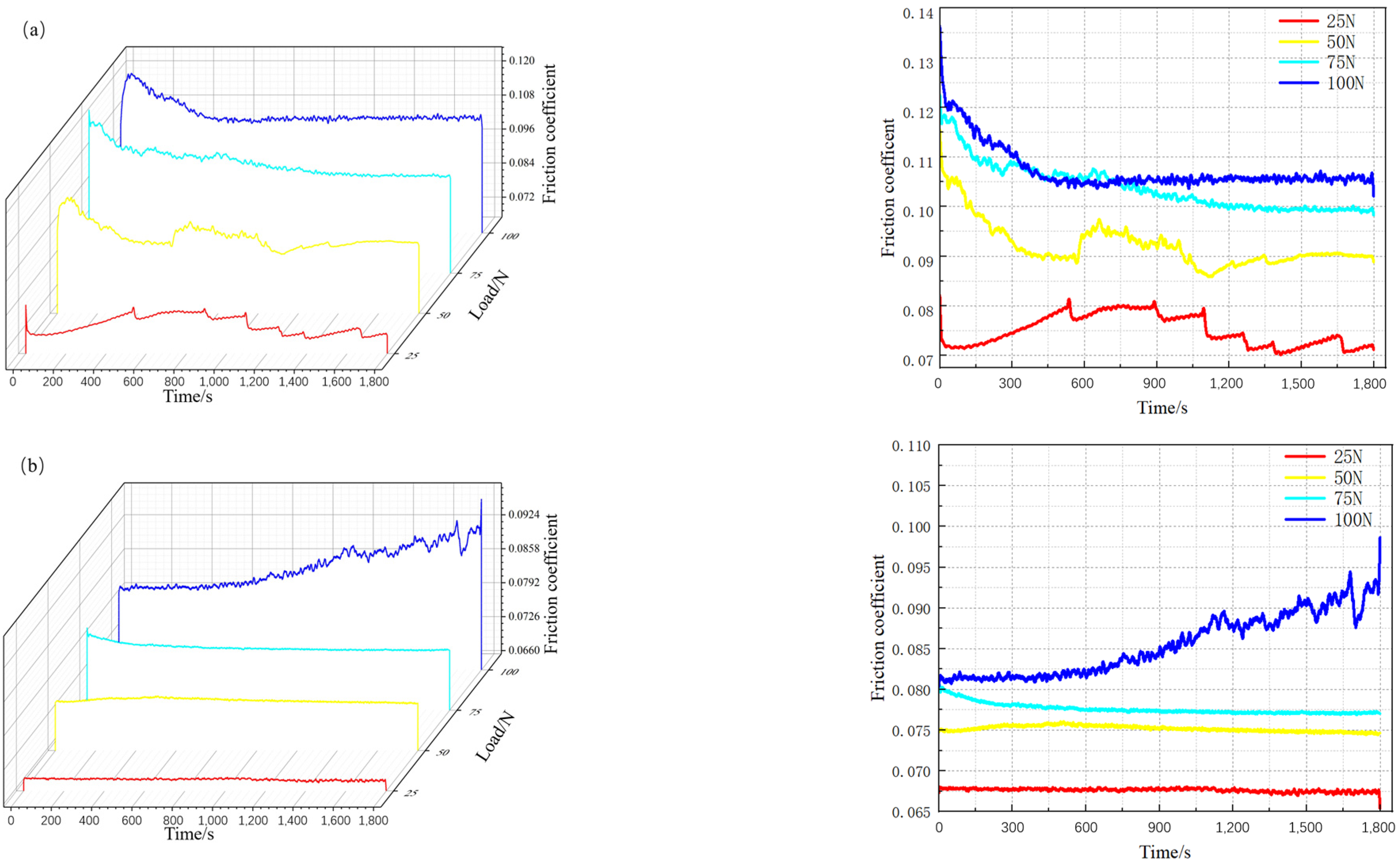

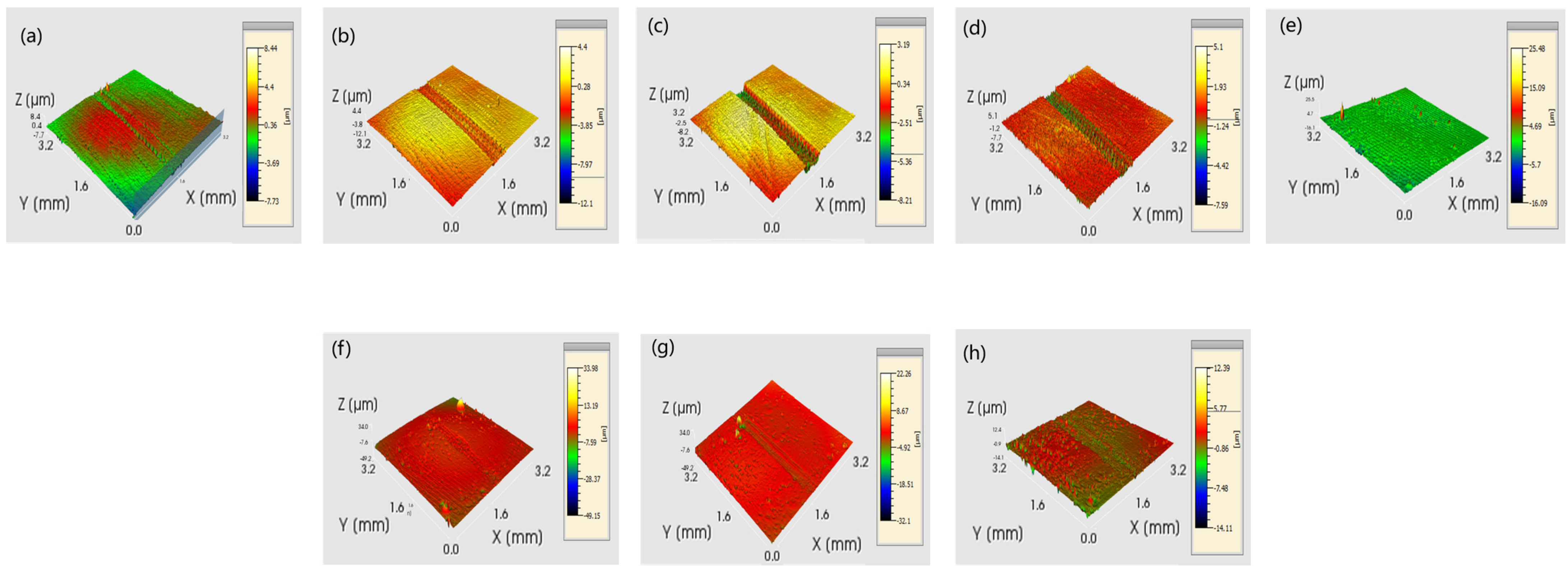
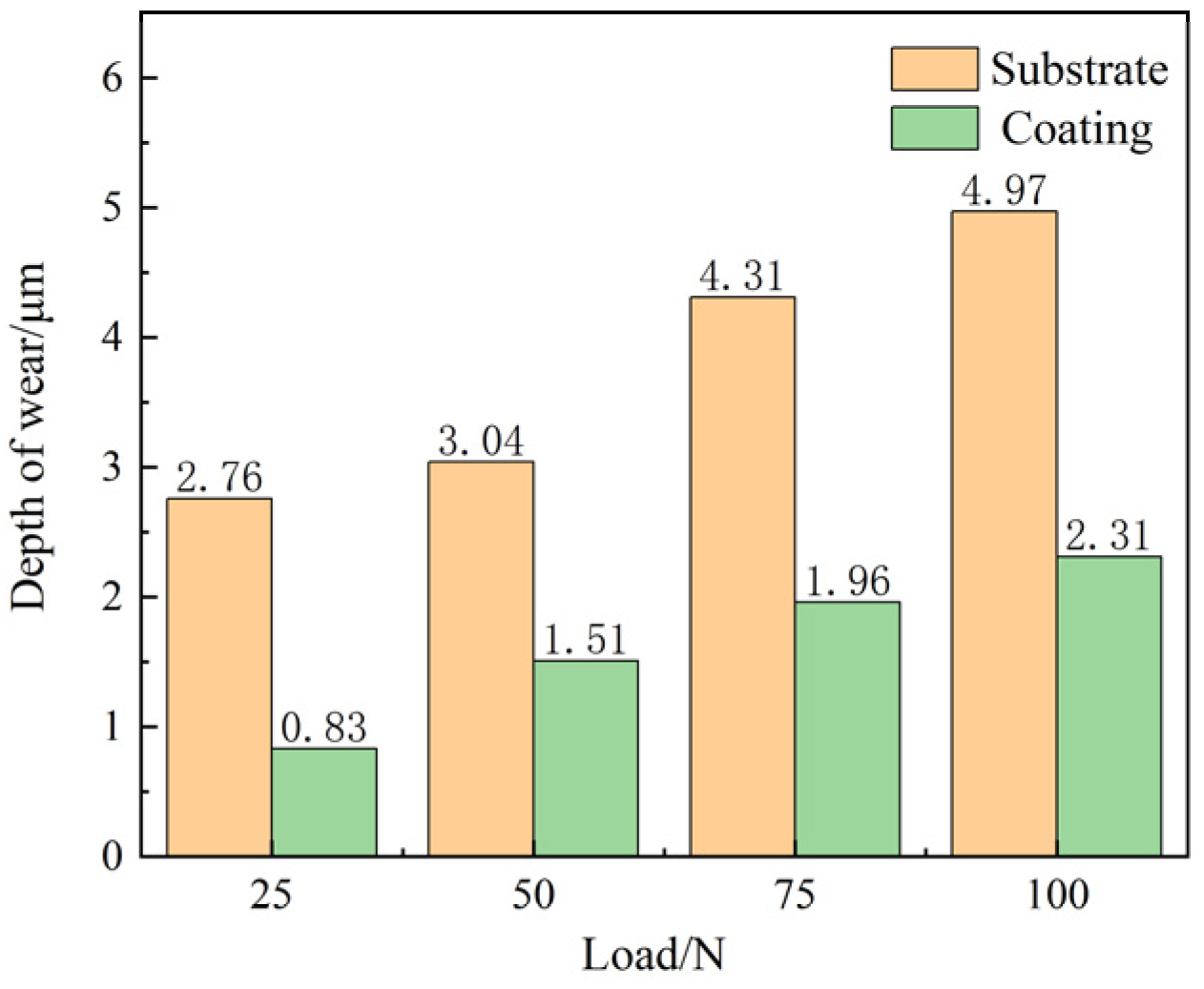
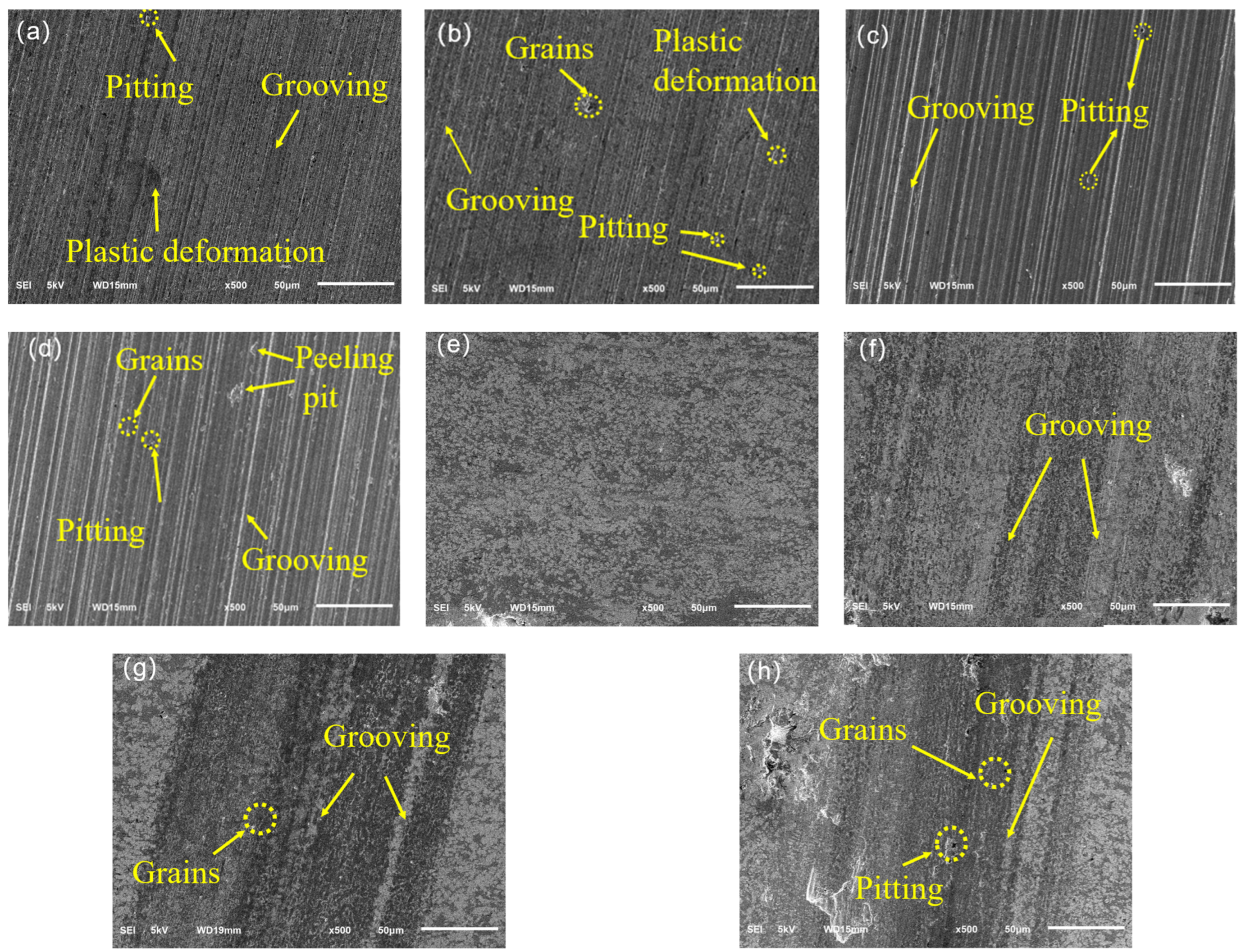

| Element | C | Si | Mn | P | S | Cr | Ni | Mo | V | Cu | Fe |
|---|---|---|---|---|---|---|---|---|---|---|---|
| Substrate | 0.15 | 0.50 | 1.52 | 0.03 | 0.01 | 1.50 | 3.60 | 0.70 | 0.06 | Bal. | |
| Powder | 8 | 4 | 1 | 60 | 17.5 | 9.5 |
| Laser Power (W) | Laser Pulse Width (ns) | Spot Diameter (mm) | Powder Feed Rate (r/min) | Laser Scanning Speed (mm/s) |
|---|---|---|---|---|
| 2200 | 20 | 3 | 0.7 | 7 |
| Frequency (Hz) | Normal Load (N) | Time (S) | Temperature (°C) |
|---|---|---|---|
| 4 | 25, 50, 75, 100 | 1800 | 25 |
Disclaimer/Publisher’s Note: The statements, opinions and data contained in all publications are solely those of the individual author(s) and contributor(s) and not of MDPI and/or the editor(s). MDPI and/or the editor(s) disclaim responsibility for any injury to people or property resulting from any ideas, methods, instructions or products referred to in the content. |
© 2024 by the authors. Licensee MDPI, Basel, Switzerland. This article is an open access article distributed under the terms and conditions of the Creative Commons Attribution (CC BY) license (https://creativecommons.org/licenses/by/4.0/).
Share and Cite
Cao, Y.; Yan, K.; Shi, W.; Zhou, R.; Li, B.; Qin, J. Experimental Study on the Microstructure and Tribological Properties of Laser-Clad Ni60-WC Composite Coatings. Materials 2024, 17, 4638. https://doi.org/10.3390/ma17184638
Cao Y, Yan K, Shi W, Zhou R, Li B, Qin J. Experimental Study on the Microstructure and Tribological Properties of Laser-Clad Ni60-WC Composite Coatings. Materials. 2024; 17(18):4638. https://doi.org/10.3390/ma17184638
Chicago/Turabian StyleCao, Yupeng, Kai Yan, Weidong Shi, Rui Zhou, Bin Li, and Jiaxin Qin. 2024. "Experimental Study on the Microstructure and Tribological Properties of Laser-Clad Ni60-WC Composite Coatings" Materials 17, no. 18: 4638. https://doi.org/10.3390/ma17184638
APA StyleCao, Y., Yan, K., Shi, W., Zhou, R., Li, B., & Qin, J. (2024). Experimental Study on the Microstructure and Tribological Properties of Laser-Clad Ni60-WC Composite Coatings. Materials, 17(18), 4638. https://doi.org/10.3390/ma17184638






